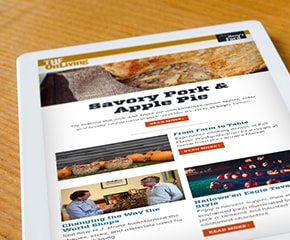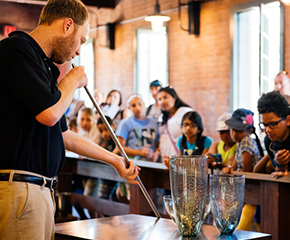
Buckling Up
11 artifacts in this set
This expert set is brought to you by:
The staff at The Henry Ford
Child's Car Seat, 1925-1935
Child safety seat
Children usually roamed free in moving vehicles in the early years of the automobile travel. Restraints, if any, were for the convenience of the parent. This child car seat from around 1930 kept the child seated and within view of mother or father. It offered little protection during an accident.
1935 Chrysler Airflow Advertisement, "Yes, Son, You're Safe in a Bridgework of Steel"
Advertisement
Ways of protecting child passengers have changed. In this 1935 Chrysler ad, children and passenger are not restrained with seatbelts or safety seats. Protection, according to the ad, comes from "a bridgework of steel." Today, children travel securely strapped into well-anchored and cushioned car seats and are much safer -- even when daddy speeds smoothly along at sixty miles per hour.
Jane Russell Demonstrating Use of Car Safety Belts, 1953
Photographic print
In the early 1950s, crash testing proved that seat belt use could prevent injury or death during automobile accidents. Indiana State Police officers used this photograph of actress Jane Russell in a presentation to persuade drivers and passengers to use safety belts. But Americans were stubborn. Even after seat belts became standard equipment in automobiles in the mid-1960s, most Americans refused to use them.
"New Ford Seat Belts, an Important Feature of Ford Lifeguard Design," 1956
Pamphlet
Ford made safety a central feature of its 1956 models with the "Lifeguard" campaign. Seat belts were a $9 option, and breakaway rear-view mirrors, reinforced door locks, padded dashboards, and steering wheels with recessed hubs were also available. Safety became an increasingly important concern for automakers, government regulators, and customers in the following decade.
Automobile Seat Belt, 1964
Safety belt
Until the mid-1960s seat belts were not standard equipment in American cars. Owners could purchase aftermarket safety belts like this one and have them installed. Continued education and growing acceptance for car occupants' safety have led most states to adopt seat belt laws.
Occupant Without Seat Belt, 20 MPH Barrier Collision," 1958
Photographic print
Seat belts were among the most important safety devices in an automobile. As this photo shows, even a low-speed crash could lead to serious injury, whether from broken glass or hard surfaces on the dashboard. Restraints protected from these dangers. Seat belts were required on all cars sold in the United States starting with the 1968 model year.
"We Can't be There to Fasten Johnny's Seatbelt before You Start... But We Can Do the Next Best Thing..." Ford Motor Company Advertising Proof, 1967
Advertisement
For years it was a common belief among automakers that "safety didn't sell." Customers were more interested in performance and comfort than protection. In the 1960s, attitudes were changing. This 1967 ad from Ford promotes a warning light that alerts drivers when a seat belt isn't buckled. It was one of several features designed to keep the vehicle's occupants safe.
Ohio License Plate, 1974
License plate
Seat belts were available on some automobiles by the mid-1950s, but most customers were indifferent to their safety benefits. Even after federal regulations required seat belts in American cars starting with the 1968 model year, many drivers and passengers simply refused to use them. Public education campaigns tried to change habits. Ohio promoted seat belt use through its license plates.
"Buckling Up" Clip from Interview with Jeanine Head Miller, 2011
Film clip
Seat belts are the single most important safety device in an automobile. Nevertheless, drivers were slow to use them. State laws, public education campaigns, and short-lived ignition interlocks -- which prevented a car from starting unless seat belts were fastened -- all promoted seat belt use. By the 1990s, buckling up was a habit for American motorists.
1984 General Motors Advertisement, "Safety is a Full-Time Job"
Advertisement
General Motors workers like Mary Ann Sanford spent each day making over 20 critical checks on seat belt systems in GM cars after they rolled off the line. Yet many Americans still didn't use these lifesaving devices -- "buckling up" wasn't yet mandatory in most states.
Saturn Advertisement, 1991, "When You Design a Car for Families"
Advertisement
General Motors' Saturn Corporation, which produced cars from 1990 to 2010, built its brand on being different from other American carmakers. Its operations were in Spring Hill, Tennessee -- far from Detroit in distance and philosophy. This 1991 ad paints the Saturn as a car designed with passenger safety foremost in engineers' minds. Special latches and seat belts keep children secure.


